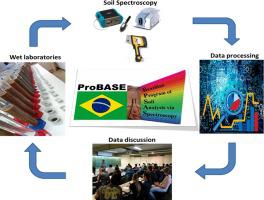Geoderma ( IF 6.1 ) Pub Date : 2022-04-26 , DOI: 10.1016/j.geoderma.2022.115905 Ariane Francine da Silveira Paiva 1 , Raul Roberto Poppiel 1 , Nícolas Augusto Rosin 1 , Lucas T. Greschuk 1 , Jorge Tadeu Fim Rosas 1 , José A.M. Demattê 1

|
Spectroscopy has been extensively used in soil analysis. However, users, such as commercial laboratories, still do not know the application, potential, and limitations of this technique. This paper aims to present a given course going from theory to practice for end-users regarding spectroscopy technique. The paper combines the use of soil spectroscopy and wet laboratories to perform a scientific-teaching dynamic using their own data, allowing for a better understanding of the technique. The course is denominated ProBASE (The Brazilian Program of Soil Analysis via Spectroscopy). Soil samples from 35 laboratories were sent (34 from Brazil and 1 from Paraguay) to a central spectroscopy laboratory. Samples were measured for visible-near-short-wave-infrared, Vis-NIR (400–2500 nm), and mid-infrared, MIR (3000–25000 nm) ranges and by portable X-ray Fluorescence (pXRF) sensor. We also used the Brazilian Soil Spectral Library (BSSL) dataset (Vis-NIR). We performed three different population models with Vis-NIR as follows: a) using the dataset of each laboratory (Local), b) using the entire ProBASE-dataset (Regional), and c) using the BSSL (Country). Afterward, we developed spectral models using the other spectral ranges for comparison. We also used a qualitative approach to detect errors from the wet laboratory analyses using Vis-NIR data and evaluated their impact on spectral modeling. The models that used Local samples had the best performance, with R2 in validation reaching up to 0.93 for clay, 0.92 for sand, 0.86 for P, 0.82 for pH, 0.81 for organic matter (OM), 0.75 for Ca2+, 0.72 for cation exchange capacity (CEC), 0.71 for aluminum saturation, 0.71 for Al3+, 0.70 for Mg2+, 0.64 for base saturation (V%), and 0.56 for K+. However, the base saturation presented greater variation from good to poor results. For the comparison dataset, the results can be summarized as follows: a) pXRF was better for P, Ca2+ B, V% and Mn; b) MIR was better for clay, sand, OM, pH, Mg2+, CEC and Mn; c) Vis-NIR was better for H + Al; d) the three spectral ranges had good performance for OM, sand, silt and clay. In addition, our findings indicate that all spectral ranges are useful for a wet laboratory, where each model has advantages and limitations, but they can be used complementary to each other. Spectroscopy can detect inconsistencies of the wet laboratory analyses, affecting thus the quality of the results. The commercial laboratory community viewed the techniques positively. The results indicate the viability to create a hybrid laboratory, combining both wet and dry (soil spectroscopy) chemistry.
中文翻译:

通过光谱分析土壤的巴西计划 (ProBASE):结合光谱学和湿实验室来了解新技术
光谱学已广泛用于土壤分析。然而,商业实验室等用户仍然不了解该技术的应用、潜力和局限性。本文旨在为最终用户介绍有关光谱技术的从理论到实践的既定课程。该论文结合了土壤光谱学和湿实验室的使用,利用他们自己的数据进行科学教学动态,从而更好地理解该技术。该课程被命名为 ProBASE(巴西土壤光谱分析计划)。来自 35 个实验室的土壤样本(34 个来自巴西,1 个来自巴拉圭)被送到一个中央光谱实验室。测量样品的可见近短波红外、可见近红外(400-2500 nm)和中红外,MIR (3000–25000 nm) 范围和便携式 X 射线荧光 (pXRF) 传感器。我们还使用了巴西土壤光谱库 (BSSL) 数据集 (Vis-NIR)。我们使用 Vis-NIR 执行了三种不同的人口模型,如下所示:a)使用每个实验室的数据集(本地),b)使用整个 ProBASE 数据集(区域),以及 c)使用 BSSL(国家)。之后,我们使用其他光谱范围开发了光谱模型进行比较。我们还使用定性方法来检测使用 Vis-NIR 数据的湿实验室分析中的错误,并评估它们对光谱建模的影响。使用本地样本的模型性能最好,R a) 使用每个实验室的数据集(本地),b) 使用整个 ProBASE 数据集(区域),以及 c) 使用 BSSL(国家)。之后,我们使用其他光谱范围开发了光谱模型进行比较。我们还使用定性方法来检测使用 Vis-NIR 数据的湿实验室分析中的错误,并评估它们对光谱建模的影响。使用本地样本的模型性能最好,R a) 使用每个实验室的数据集(本地),b) 使用整个 ProBASE 数据集(区域),以及 c) 使用 BSSL(国家)。之后,我们使用其他光谱范围开发了光谱模型进行比较。我们还使用定性方法来检测使用 Vis-NIR 数据的湿实验室分析中的错误,并评估它们对光谱建模的影响。使用本地样本的模型性能最好,R2在验证中,粘土达到 0.93,沙子达到 0.92,P 达到 0.86,pH 达到 0.82,有机物 (OM) 达到 0.81,Ca 2+达到 0.75 ,阳离子交换容量 (CEC) 达到 0.72,铝饱和达到 0.71, Al 3+为0.71 ,Mg 2+为0.70,碱基饱和度 (V%) 为 0.64,K +为 0.56 。然而,基础饱和度呈现出从好到差的更大变化。对于比较数据集,结果可总结如下: a) pXRF 对 P、Ca 2+ B、V% 和 Mn 更好;b) MIR 对粘土、沙子、OM、pH、Mg 2+更好, CEC 和 Mn; c) Vis-NIR 对 H + Al 更好;d) 三个光谱范围对 OM、沙子、粉砂和粘土具有良好的性能。此外,我们的研究结果表明,所有光谱范围都对湿实验室有用,其中每个模型都有优点和局限性,但它们可以相互补充使用。光谱学可以检测湿实验室分析的不一致,从而影响结果的质量。商业实验室社区对这些技术持积极态度。结果表明创建混合实验室的可行性,将湿法和干法(土壤光谱)化学相结合。



























 京公网安备 11010802027423号
京公网安备 11010802027423号